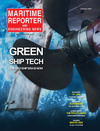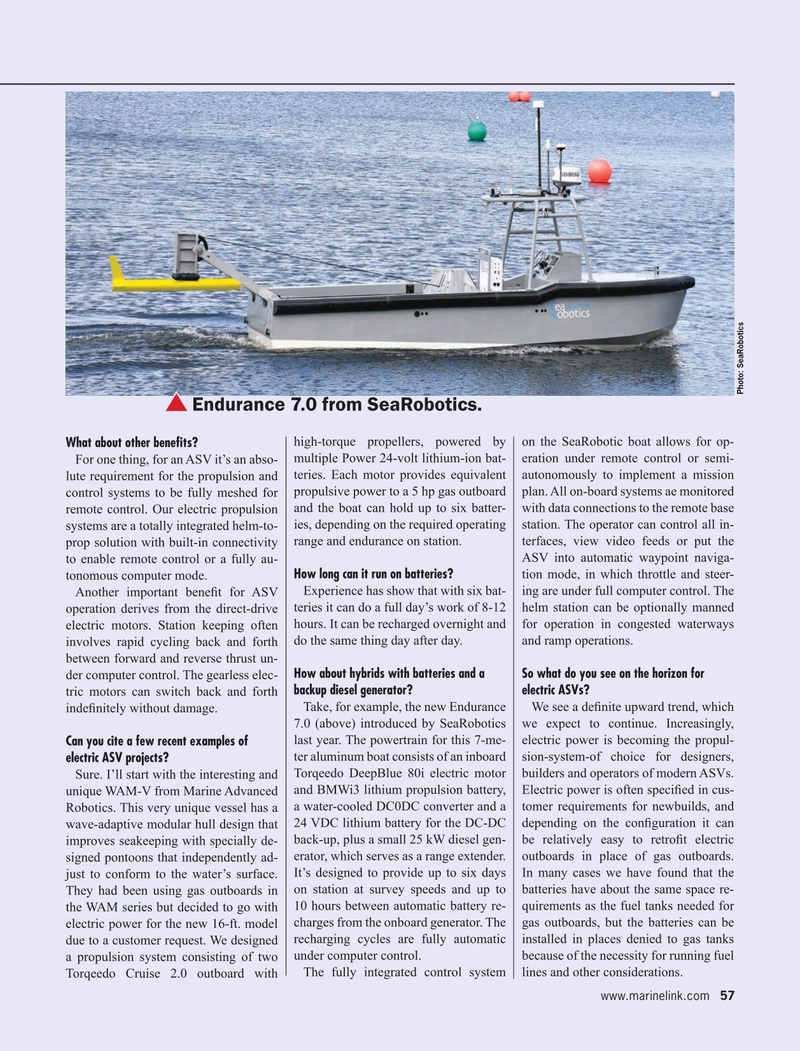
Page 57: of Maritime Reporter Magazine (February 2020)
Green Ship Technology
Read this page in Pdf, Flash or Html5 edition of February 2020 Maritime Reporter Magazine
Photo: SeaRobotics
Endurance 7.0 from SeaRobotics.
high-torque propellers, powered by on the SeaRobotic boat allows for op-
What about other bene? ts?
multiple Power 24-volt lithium-ion bat- eration under remote control or semi-
For one thing, for an ASV it’s an abso- lute requirement for the propulsion and teries. Each motor provides equivalent autonomously to implement a mission control systems to be fully meshed for propulsive power to a 5 hp gas outboard plan. All on-board systems ae monitored remote control. Our electric propulsion and the boat can hold up to six batter- with data connections to the remote base ies, depending on the required operating station. The operator can control all in- systems are a totally integrated helm-to- prop solution with built-in connectivity range and endurance on station. terfaces, view video feeds or put the
ASV into automatic waypoint naviga- to enable remote control or a fully au-
How long can it run on batteries? tion mode, in which throttle and steer- tonomous computer mode.
Experience has show that with six bat- ing are under full computer control. The
Another important bene? t for ASV operation derives from the direct-drive teries it can do a full day’s work of 8-12 helm station can be optionally manned electric motors. Station keeping often hours. It can be recharged overnight and for operation in congested waterways involves rapid cycling back and forth do the same thing day after day. and ramp operations.
between forward and reverse thrust un-
How about hybrids with batteries and a So what do you see on the horizon for der computer control. The gearless elec- tric motors can switch back and forth backup diesel generator? electric ASVs?
Take, for example, the new Endurance We see a de? nite upward trend, which inde? nitely without damage.
7.0 (above) introduced by SeaRobotics we expect to continue. Increasingly, last year. The powertrain for this 7-me- electric power is becoming the propul-
Can you cite a few recent examples of ter aluminum boat consists of an inboard sion-system-of choice for designers, electric ASV projects?
Sure. I’ll start with the interesting and Torqeedo DeepBlue 80i electric motor builders and operators of modern ASVs. unique WAM-V from Marine Advanced and BMWi3 lithium propulsion battery, Electric power is often speci? ed in cus-
Robotics. This very unique vessel has a a water-cooled DC0DC converter and a tomer requirements for newbuilds, and wave-adaptive modular hull design that 24 VDC lithium battery for the DC-DC depending on the con? guration it can back-up, plus a small 25 kW diesel gen- be relatively easy to retro? t electric improves seakeeping with specially de- erator, which serves as a range extender. outboards in place of gas outboards. signed pontoons that independently ad- just to conform to the water’s surface. It’s designed to provide up to six days In many cases we have found that the
They had been using gas outboards in on station at survey speeds and up to batteries have about the same space re- the WAM series but decided to go with 10 hours between automatic battery re- quirements as the fuel tanks needed for electric power for the new 16-ft. model charges from the onboard generator. The gas outboards, but the batteries can be due to a customer request. We designed recharging cycles are fully automatic installed in places denied to gas tanks a propulsion system consisting of two under computer control. because of the necessity for running fuel
The fully integrated control system lines and other considerations.
Torqeedo Cruise 2.0 outboard with www.marinelink.com 57
MR #2 (50-65).indd 57 2/7/2020 10:11:13 AM

 56
56

 58
58
